Barefoot sandals are a way that barefooters sometimes use to look like they are shod while still maintaining sole-to-ground contact. In other words, they are used to try to foil the shoe police. For me, at least, that contact with the ground is what provides me with the main sensory input that keeps my proprioception working. It is also the thing that allows me to walk in a way that does not hurt my feet and knees and back (a benefit many other barefooters have also realized).
Barefoot sandals can also be used as jewelry or decoration for the feet.
Most barefoot sandals that you can buy are aimed more at women. You can see some women’s vendors and styles here, here, and here. (Note: this is not any particular endorsement of these particular sites; they are just some of the first that came up on Google.) There is also a page on barefoot sandals that lists quite a few vendors on the website of the Barefoot Hikers of PA (NJ-DE-MD). There aren’t a whole lot available for men, though I did find this site. You’ll note that most of these are really aimed more at decoration that as fooling personnel at a store or restaurant who are intent on keeping out a barefooter (usually for misguided and mythical reasons).
Way back when I just made my own. It’s fairly easy to do. If you’d like to try to make some of your own, here they are, and the general idea for their construction.
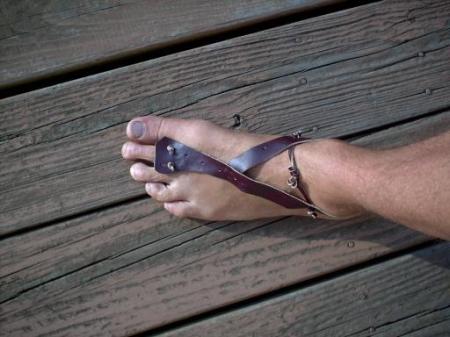
Thin leather with knotted thong ties
This one is made from leather, cut with scissors. The loop under the second toe is just a thin strip (thong) held on by those knots you see. The strap across the top a two short thongs. They are held together with a loop and knot arrangement (small loop on one side; knot on the other; pull the knot through the loop and it stays).
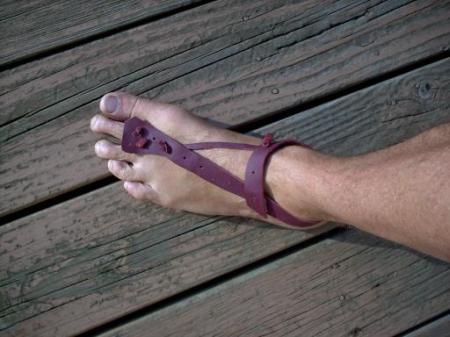
Thin leather with some velcro
This one is also leather, with a slightly different attachment arrangement, and a slightly different look. Same arrangement under the toe. This time, however, the large strip is the cross-strip, while the thong runs back towards the toe. The thong is knotted on both end. The cross-strip, however, is attached with velco. You can see the construction in the next photo.
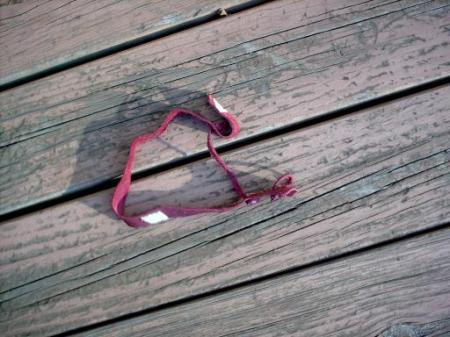
View of the velcro attachment points
Here you can see the toe-loop on the right. You can also see where the velcro is attached. Of course, sizing (and placement of the velcro) is done while it is on your foot.
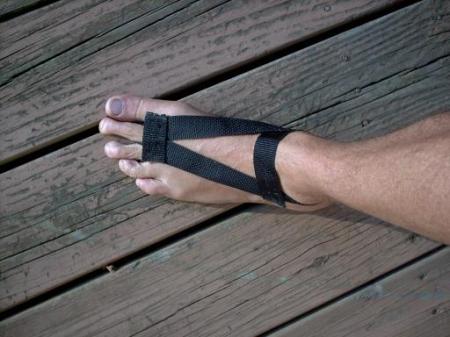
Nylon straps
Here is a more masculine one. This is made from backpacking straps (available at any outdoor store). It is bigger and bulkier, with the intent to do a better job of fooling anybody who looks at it. That broader patch across the toes is kind of trying to hide the fact that the attachment is a loop under the second toe (and not a single piece between the big and 2nd toes. Doesn’t succeed all that well, in my opinion. The loop under the toe is just a piece of shoelace. The cross-piece is stitched on one side, and held on with velcro on the other.
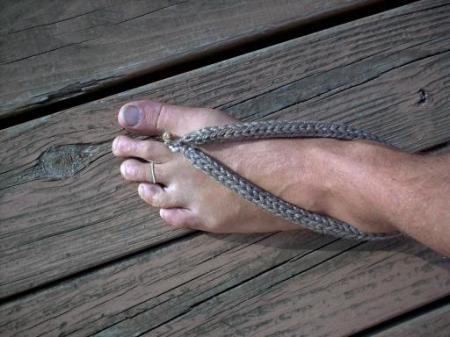
Braided (Knitting Knobby)
This is the one I think I like the best. It goes easily into a pocket without getting tangled up like the others, and is easiest to put on (big loop behind the ankle, little loop under the toe).
This was made with a knitting knobby. Well, actually, I made my own knitting knobby (with a board and nails) that would take a thicker piece of string, and produced a wider product at the end. I see that there is something call a knitting tower that is similar to what I did.
The toe-loop is a piece of elastic string tied at the same place the big loop is tied together. This really does go down between the big and 2nd toes, and then is looped over the 3rd toe. This has more of the look of a flip-flop (and thereby might fool others better).
Despite making all these, I find I rarely (I mean really rarely) wear them. If I am going into a place I’ve never been in before, I will not wear them. That is because, if I do wear them and have no problems, I’ll never know if I could have just gone barefoot and had no problems. They are not worth carrying in my pocket in case I am challenged. If I am challenged when barefoot, and stop to put them on, they will see me putting them on, realize that they are not real sandals, and then they will probably still throw me out. Finally, for places that do throw me out for going barefoot, my usual policy is not to got there again. If they don’t want me, why should I give them my money when there are other places who welcome me barefoot? So, as I said, I very rarely wear them.
There is one kind of situation in which I will use (and have used) them, though. That is for a place that has thrown me out that I really, really need to enter (and they are often a monopoly of some sort). One was the Franklin County Law Library. I had used this library (research for my lawsuit) many times barefoot when suddenly they put up a sign (passed by their board of trustees and everything). So I put these on to go in. Interestingly, I got some books and was sitting down looking at them (kind of hiding in the rear of the room among the carrels) when I saw the librarian coming towards me to check me out. The barefoot sandals must have passed muster, because she looked at my feet (rather carefully) as she went by, and then continued on without hassling me. Now, maybe I fooled her. Or maybe she thought the shoe rule was stupid but was still required to enforce it, and while she recognized the barefoot sandals as not real shoes, that gave her the excuse she needed not to enforce the rule any further. Either way, it worked sufficiently. I’ve done this before at the Columbus Metropolitan Library (the one I lost my suit against) twice. Once I had to accompany my son there to get something, and once they were the only source I could use to get a copy of a newspaper article about the Youngstown barefoot lawsuit from the 1960s. That Youngstown barefooter won.
I’m still a little leery about using them in places I’ve been thrown out of. If they really pursued it, they could probably arrest me for criminal trespass, and that I ought to know that a shoe rule means that such barefoot sandals are not adequate. Even if they ban “bare feet”, a prosecutor could argue that I am just being pedantic, and that a reasonable person knows what is required (a sole).
Finally, one more reason I very rarely wear them: I can feel them on my feet. Yes, my soles are still free, but I still feel the barefoot sandal on top. And it just doesn’t feel “bare.”







